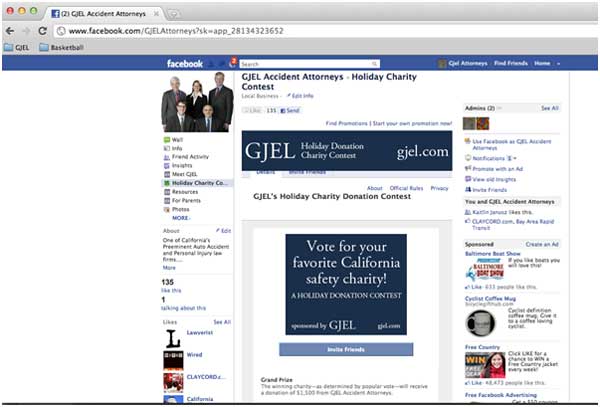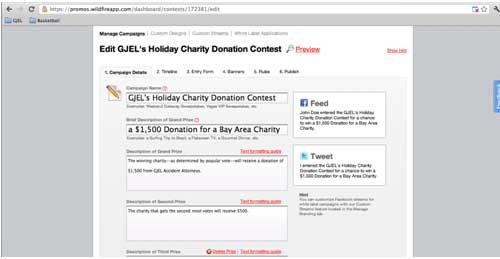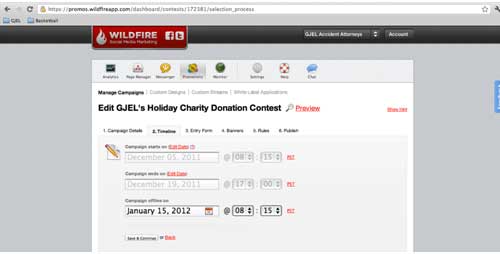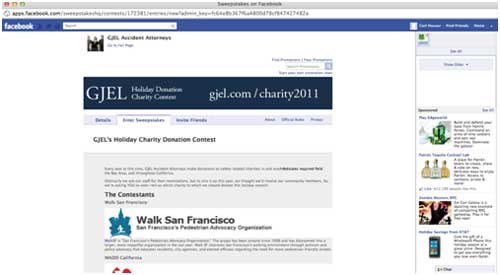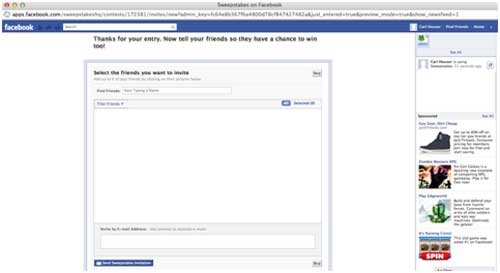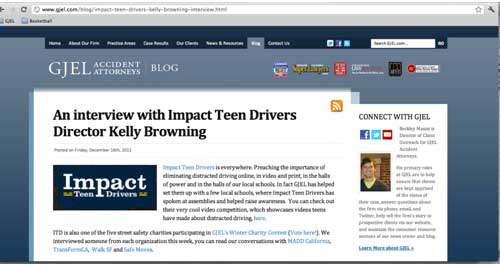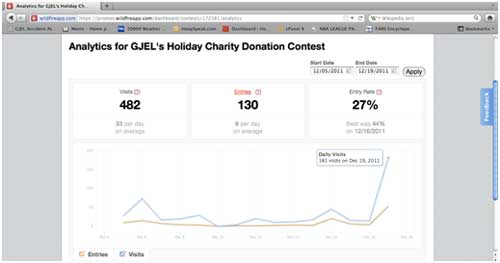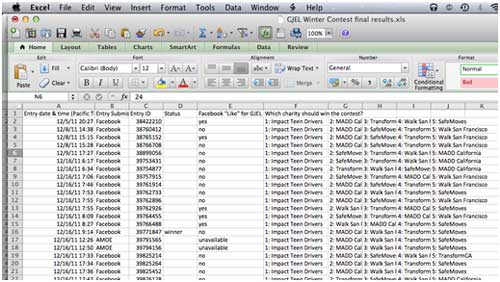For most companies, the end of the year is a time to give. Holiday season coincides with fiscal deadlines…encouraging tax-deductible giving to non-profits and charities. But just because a firm gives to charity, doesn’t mean that the altruistic gesture can’t benefit both parties. In the winter of 2011, we at GJEL Accident Attorneys tried a new model of charitable giving that enhanced the value of the gift both to the recipients and to our firm.
Instead of simply sending our check with a letter, we decided to engage the charities in our area that align with a cause we invest in throughout the year: street safety. Using Wildfire, an application that allows anyone to run a vote-based contest on Facebook, we hoped to help the charities develop their social media presence, introduce people to new charities, and also promote our own Facebook page in the process.
Wildfire embeds simply in Facebook, and we ran the contest from our firm’s Business Page in order to make it easy for people to “like” us after participating. The application allows you to track visits to the competition, where the votes are coming from (to prevent fraud) and offers live reporting of votes.
The contest was simple: users ranked five charities by which ones they thought were most deserving, the votes were tallied and donations were given to each charity depending on how well they placed. We donated 60 percent of the pool to the first place winner 20 percent to the second place charity and about 7 percent to the remaining participants.
Voting was open for two weeks between Monday, December 5th and Monday, December 19th.
After we determined the rules of the competition and which application we would use to run it, we searched for the best charities.
Selecting Charities
Since our firm specializes in auto accidents, we decided to focus on street safety charities. In addition to selecting two charities we already had relationships with, we also wanted to reach out and make some new connections. To find additional non-profits whose goals might align with our own, we used Charity Navigator. The three mission focuses we searched for were cycling advocacy organizations, pedestrian advocacy organizations, and auto safety organizations.
We knew we wanted to support Walk San Francisco and Impact Teen Drivers beforehand, and selected Mothers Against Drunk Driving California, TransFormCA, and Safe Moves from the lists on Charity Navigator. Our primary criteria was how well the organizations were rated on Charity Navigator, though we also wanted organizations that were well established as we believed they would drive the greatest number of participants.
Building the Wildefire App
Building the Wildfire App is not exactly a pain free process. But for what it provides, the cost and functionality are solid. The primary appeal of Wildfire is how seamlessly it integrates with Facebook.
We customized the colors to match the rest of our Facebook page’s palette and the contest rules and text using the Wildfire App’s back end tools.
Here are some of the basics:
Setting the contest parameters:
When a user entered the contest, the finished product looked like this, beginning with an introduction to the charities involved:
Users entered their contact information (which we only needed to prevent fraud) and could be done reading and submitting in just a couple minutes. After submitting, the user was given the opportunity to post the vote on his or her wall, and share with friends:
Promoting the Contest
Once we had the contest built, it was important to get buy in from the charities involved. Although the first day, when we announced the contest, saw a decent number of submissions and views, we soon found that they were enthusiastic about participating, but not so enthusiastic about doing the legwork to promote it.
To help with this, we did a series of interviews with a leader of each charity to help them get to know us, and to form a personal connection with the project. These interviews were published on our firm’s blog, and run one at a time on each day of the second week (Dec 12-16) of the contest.
The trend here was that whichever charity we highlighted that day got a little bump from the people involved telling friends and coworkers about the interview. It was also a reminder to pressure organization workers to make sure they voted.
We also sent out a number of emails, one at the end of the first week and then three more over the course of the next week and weekend to update the participating organizations about the rankings and to give them simples tips like how leveraging their personal Facebook and email networks to help them could improve their positions.
After the competition, one charity told us that these emails had an enormous impact because they gave a tangible sense of how things were going, which made the competition feel more vital. It’s no surprise that this group, TransFormCA, is also the group that came out on top!
We increased the frequency of email communication as the deadline for submissions grew near, but the imminent deadline was likely the greatest factor for inspiring action.
Tallying the Votes
As you can see in this image of WildFire’s backend analytics, voting really spiked at the end of the competition:
The entry rate was 27 percent. We aren’t certain why the rate was so low, it’s strange that so many people visited but did not enter. Possible reasons for this are:
- Our form asked participants to rank all five organizations. It’s possible that this caused visitors to think twice about participating. Though it’s not much of a task to rank each organization, online people expect things to be as simple as possible.
- The Facebook app asks for a certain amount of Facebook permissions and information. This, we heard from some, was a factor because users believed that as a law firm, our real ambition was to acquire their personal information. The large disclaimer that their information would not be shared and that their email addresses would be deleted at the end of the competition did not assuage fears.
- People clicked through to the link from our blog or from another site but did not feel compelled to actually vote.
Once voting was closed, we downloaded the data from WildFire to an excel file. It took a little bit of wrangling to make it easy to count votes, because what WildFire is really set up to do is choose a random winner from a list of entrants. In this case there was no prize for voters, what we were interested in was who they voted for.
Here’s how the sorted data looked:
Notice that WildFire also tracks whether the person who filled out the form “liked” our Facebook page. Gaining Facebook supporters is a trick for a personal injury firm, and we increased our likes by more than 25 percent through this project.
After tallying all the votes, we contacted each charity individually then did one final blog post on the contest to announce the winners.
Learning From Our Mistakes
Four of our five charities showed great initiative, but ultimately we may have picked groups that were a bit limited in their constituency and online presence. Ideally, each organization would not only line up with our mission interests, but also have an active blog, Twitter and Facebook presence. This would activate a greater base of constituents who would not only be interested in voting, but would be comfortable with the amount of information they were asked to share in order to vote. We did not take these characteristics into account when picking charities, which represents a missed opportunity to take advantage of the promotion to our fullest abilities. However, we were very happy to support the charities that we did connect with, and know that the money will go to a great cause.
In hindsight, it also would have been a good idea to change the voting form so it didn’t require ranking all five participants. When it comes to user experience, the fewer clicks the better!
Lastly, we were a bit rushed in the front end of this contest, so we didn’t devote enough time and energy to helping get all the charities to buy in fully and develop a plan of action for obtaining involvement from their supporters.
Still, despite these minor hiccups, the Winter Charity Contest was an overwhelming success and GJEL is proud to have supported such worthwhile and deserving charities. We hope to continue building our relationships with each of these incredible organizations over the coming year.

